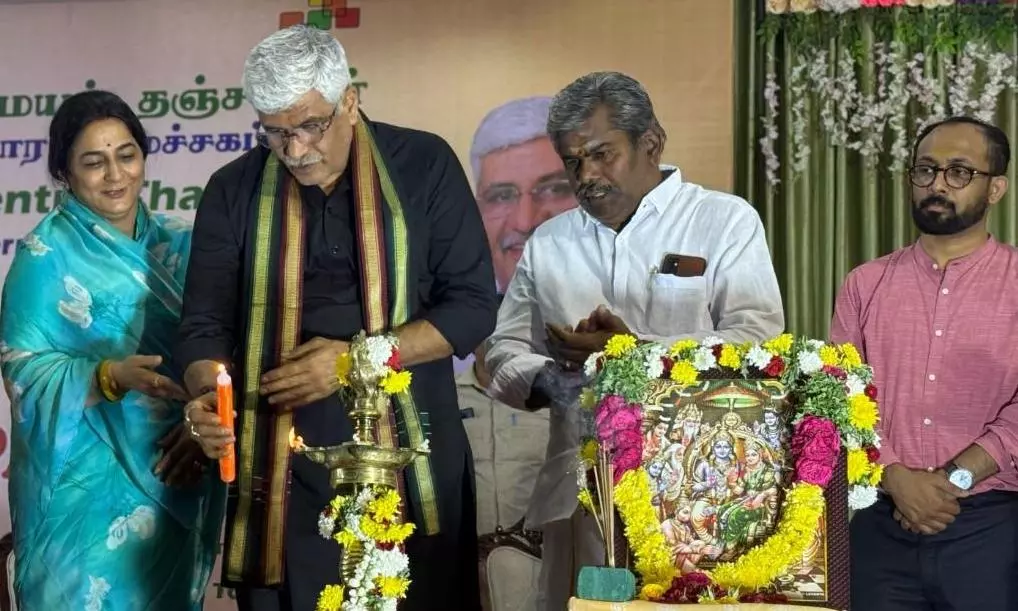
Centre's zeal to promote Tamil poet Kambar's birthplace, legacy sparks debate
ASI excavations show no evidence to prove Kambar Medu is linked to Kambar; also, experts debunk Centre's claims that Kamba Ramayanam recital is going extinct

Amid the raging three-language formula row, the Narendra Modi government's move to promote Tamil poet Kambar’s birthplace through a museum, and organise events to celebrate his magnum opus Kamba Ramayanam, is ruffling feathers in Tamil Nadu.
Considering no archaeological evidence has established Kambar Medu as the birthplace of the 12th-century poet, the Union Culture Ministry's decision to establish a museum there is largely viewed as a BJP effort to shed its anti-Tamil image. Kambar Medu is located at Therazhundur village, in Tamil Nadu's Mayiladuthurai District.
Although based on Valmiki's Ramayana, Kambar’s version differs in various aspects and is known more for its literary excellence and linguistic richness than for its spiritual elements. The Kamba Ramayanam epic contains over 10,000 verses across 113 sections in six chapters.
Also read: Penguin to publish English translation of Kampan's 'Ramayana'
No link to Kambar
A release from the Union Culture Ministry says a museum dedicated to the life and works of Kambar and Kamba Ramayanam will be established at Kambar Medu, ensuring that the epic’s legacy is preserved for future generations.
However, a report accessed by The Federal on excavations conducted by the Archaeological Survey of India (ASI) between 1982 and 1984 at Kambar Medu says: "The site did not yield any evidence with regard to its association with poet Kambar, the author of Ramayana in Tamil.’’
The excavations, led by ASI archaeologists CL Suri and P Narayana Babu, uncovered ceramics, ornaments, terracotta objects, and a soakage pit. The findings indicate that the site was occupied by the early Megalithic people with late Neolithic remnants, followed by the medieval period. Among these discoveries, there was no evidence linking the site to Kambar.
No evidence, says expert
The Federal spoke to KT Gandhirajan, a renowned rock art expert who has delivered lectures on the depiction of the Kamba Ramayanam in temple sculptures, to ask him if there is any other evidence besides ASI reports to establish the poet's birthplace.
None in his opinion, he said. “We can find many temple sculptures depicting the Kamba Ramayanam. However, there is no clear literary or archaeological evidence, except for a later-period poem referencing a dancer who mentioned her native place as 'Therazhundur, the birthplace of Kambar and the site where the river Cauvery flows'. We cannot rely solely on this reference to justify establishing a museum,” he said.
'Political gimmick'
V Arasu, former head of the Tamil Department at Madras University, echoed Gandhirajan’s views.
“As a Tamil professor, I do not consider the initiative to set up a museum for Kambar as an effort to promote the Kamba Ramayanam. Earlier, the BJP attempted to project Thiruvalluvar as a Hindu saint and organised events related to Saint Agathiyar during the Kashi Tamil Sangamam event in Varanasi. Now, they are organising events to honour poet Kambar,” he said.
Arasu further argued that the ministry’s plan to revive and sustain the Kamba Ramayanam through recital and symposium events in March and April 2025 is merely a 'political gimmick'.
“Rather than establishing a museum for a Tamil poet, people in Tamil Nadu would appreciate it more if the Union government withdrew from enforcing the National Education Policy (NEP) and the three-language policy in the state. Kamba Ramayanam is already a part of the Tamil language syllabus, and its recital is a common practice in schools, colleges and temples,” he added.
Also read: Centre unfair to Tamil Nadu, progressive states: DMK MP Siva
Going extinct?
However, the ministry had raised an alarm that the cultural practice of reciting Kamba Ramayanam is at the risk of going extinct in Tamil Nadu.
A press release related to recitation events organised by the ministry said, “Although once integral to Tamil cultural life, the oral tradition of reciting the Kamba Ramayanam through local mandalis (cultural troupes) has significantly declined. Many younger generations in Tamil Nadu are now unfamiliar with Kambar's epic, and the cultural practice is at risk of extinction.’’
When The Federal interacted with Tamil literary clubs, school teachers, and Kambar clubs, they refuted this claim. They said recitation and performances related to the epic remain vibrant in the state.
'Celebrated and cherished'
Akbar Ali, a Tamil professor and an orator of Kamba Ramayanam for over a decade, shared that hundreds of literary clubs actively celebrate the poet's work. He added that the performance of the Kamba Ramayanam as a play is an important part of village temple festivals.
The epic is presented in various forms such as street play, folk dance and parayanam (ceremonial recitation) in temples, Ali added.
According to him, Kamba Ramayanam is celebrated as a historic work by Tamil scholars, and almost every district in Tamil Nadu has a Kamban kazhagam (club) dedicated to promoting the epic.
Widely read
The work is cherished more for Kambar’s linguistic prowess than its storyline. Hundreds of orators, including Ali, are invited annually by Tamil literary groups to present lectures and recitations on the epic, Ali said.
He added that his personal experience of growing up reciting Kambar’s verses eventually led him to become an orator.
“Recently, I was invited as a judge for a school event on the Kamba Ramayanam in Madurai. The enthusiasm of the students was remarkable. I was in awe of their recitations, which demonstrated a deep understanding of the language and meaning. The claim that the younger generation in Tamil Nadu is unfamiliar with the epic is simply not true,” he concluded.

